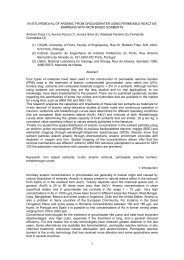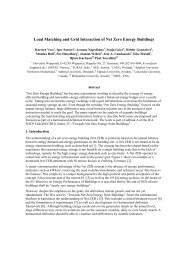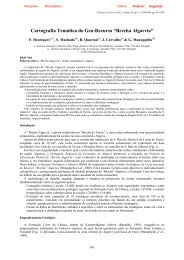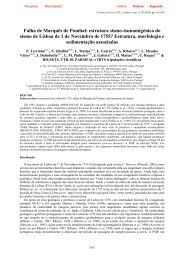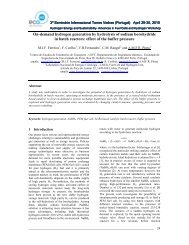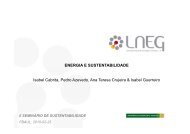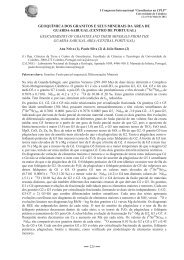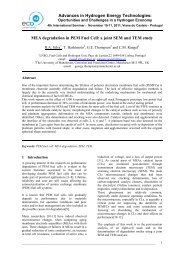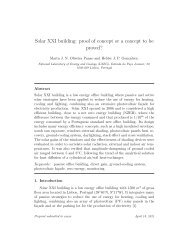Life Cycle Assessment of a Multi-Material Car Component
Life Cycle Assessment of a Multi-Material Car Component
Life Cycle Assessment of a Multi-Material Car Component
- No tags were found...
Create successful ePaper yourself
Turn your PDF publications into a flip-book with our unique Google optimized e-Paper software.
Automotive Sector<strong>Car</strong> <strong>Component</strong>scycle impact assessment <strong>of</strong> a car component, which is part<strong>of</strong> a car brake system booster. The case study presented inthis paper is the result <strong>of</strong> a broader R&D project developedby a partnership involving industry, universities, technologicalcentres and research institutes from different Europeancountries (Portugal, Spain and Germany). In this particularcase-study, a multi-material car component is modified byits original manufacturer in order to explore a new multimaterialinjection moulding process where just recyclablematerials will be used. The LCA methodology is used toassess the new and the current car components throughouttheir respective life cycles in order to evaluate the correspondingenvironmental impacts and, thus, verify if the newcomponent has a lower environmental load, and which phaseis contributing more to the global environmental impact.The LCA is an important tool for guiding environmentaldesign improvements in the automotive industry [2] and significantcontributions are already available focusing on theLCA for the automotive sector. In particular, Keoleian et al.1998 have conducted a comparative assessment <strong>of</strong> a multilayerHDPE fuel tank and a steel fuel tank. A major conclusionfor both tank systems was that the use phase accountsfor the majority <strong>of</strong> the energy consumed and that the HDPEfuel tank system is environmentally preferable overall to thesteel tank system [2]. Three air intake manifold designs werealso studied by Keoleian and Kar 2003, using life cycle inventoryanalysis and life cycle cost analysis, underlining onceagain that the use phase accounts for the greatest fraction <strong>of</strong>energy consumed on the whole life cycle, in this particularcase being that the manifold weight is the single, most importantdeterminant <strong>of</strong> life cycle energy [3].1 MethodologyTo evaluate the environmental aspects and potential impactsassociated with the car component under scope, fromraw material acquisition to final product disposal, an LCAmethodology was used based on ISO (International Organizationfor Standardization) recommendations [4–7]. Makinguse <strong>of</strong> the LCA s<strong>of</strong>tware SimaPro 6.01 [8], the environmentalimpact <strong>of</strong> the new and current car component wasassessed using the problem-oriented approach (CML 2baseline 2000) [9]. As an option for a sensitivity analysisapplication, an endpoint-oriented approach (Eco-indicator99) [10] was used.2 Goal and Scope <strong>of</strong> the Study2.1 GoalThe goal <strong>of</strong> the LCA is to identify options for improving theenvironmental performance <strong>of</strong> the car component. The results<strong>of</strong> this study will be used for product and process development.The component manufacturer wants to be ableto analyse the effects <strong>of</strong> changes in its processes, in terms <strong>of</strong>technology, inputs and product composition, on the totalenvironmental impact. This information, in turn, can be usedto prioritise different measures that can be taken to improvethe environmental performance. This LCA does not aim atpublic comparative assertions, so that an expert review willnot be carried out. The study was conducted by INETI, aresearch institute, within a project coordinated by the companyIber-Oleff and including also other companies, technologicalcentres and universities. The commissioner wasfrom the Portuguese Innovation Agency. Interested partiesare mainly part <strong>of</strong> the automotive industry.2.2 Product and scenarios descriptionThe product under scope consists <strong>of</strong> a car component, whichis part <strong>of</strong> the brake system booster. It has 4 sub-components:a spring, a washer, a poppet and a poppet-retainer. For LCApurposes, two cases are addressed: the current product, whichis described by the reference scenario and the new car componentbeing developed, which is described by the alternativescenario. A more detailed description <strong>of</strong> these two scenariosis given below.The reference scenario. In the reference scenario two <strong>of</strong> thesub-components are steel made, one is vulcanised rubber(EPDM) made and the other is based on an engineering plastic(POM). Composition details under this scenario are indicatedin Table 1.Table 1: Reference component composition [11]Sub-components <strong>Material</strong> Weight (g)Spring Wire DIN 2076-D; DIN 17223 2.00Washer Steel St2, LG BK-DIN 1624 5.20Poppet EPDM rubber 5.50Poppet-retainer POM 3.75Steel factory(Holand)Steel factory(Holand)EPDM factory(Germany)POM factory(Germany)Steel Spring factory Spring600 km (Germany) 600 km2.45 km*kg 2.40 km*kgSteel Washer factory Washer700 km (Germany) 700 km9.10 km*kg 7.28 km*kgEPDM600 km16.50 km*kgPoppet factory(Germany)Poppet600 km6.60 km*kgPOM Poppet-ret. factory Poppet-ret600 km (Germany) 600 km11.25 km*kg 4.50 km*kgTotal=16.45The spring is manufactured by rolling and the washer ismanufactured by cutting, and then undergoes a surface treatmentby immersion zinc phosphating. The poppet is manufacturedby injection moulding, followed by vulcanisation,and the poppet-retainer is made by injection moulding. Thecomponent is then obtained by manually assembling thesefour sub-components.Throughout each sub-component production, there is a loss<strong>of</strong> raw materials (steel, EPDM and POM). It is assumedthat the steel and the POM production wastes are recycledand that the EPDM production waste is incinerated. Thefour sub-components and their subsequent assembly areperformed in Germany. The distances and loads involvedduring the transportation steps performed by a 28 t truckare indicated in Fig. 1.Fig. 1: The distances and loads involved in the reference scenarioProduct factory(Germany)Int J LCA 12 (5) 2007 337





